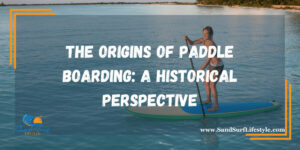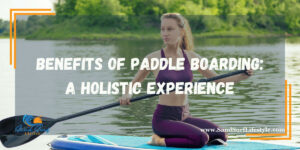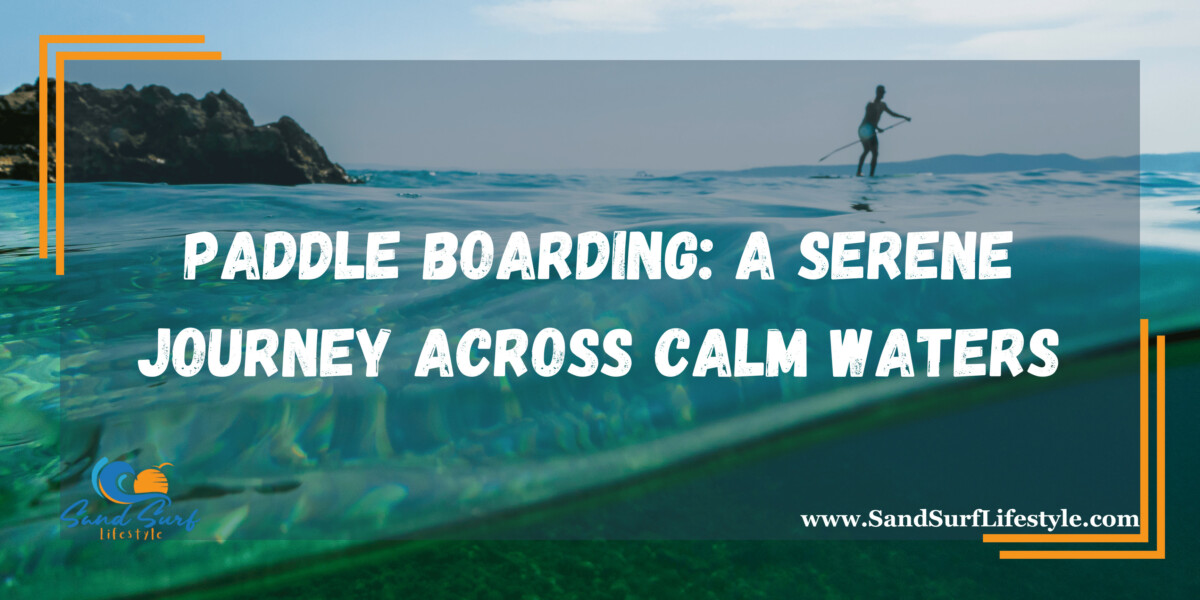Paddleboarding, often abbreviated as “SUP” (Stand-Up Paddleboarding), is a water activity that has been steadily gaining popularity among outdoor enthusiasts and water sports aficionados. At its core, paddle boarding is a simple yet exhilarating experience that involves standing on a large, stable board and using a paddle to propel yourself across the water. It offers an opportunity to connect with nature, stay active, and enjoy moments of serenity on serene waters.
The Origins of Paddle Boarding: A Historical Perspective

Paddleboarding, as we know it today, owes its origins to the idyllic shores of Hawaii. Although the concept of standing on a board and paddling has ancient roots in different cultures, it was the innovation of Hawaiian surfers that shaped the modern iteration. In the 1940s and 1950s, specifically in the iconic coastal area of Waikiki, legendary figures known as the “Waikiki beach boys” began to experiment with this novel approach to wave riding.
These early pioneers, deeply ingrained in Hawaiian surf culture, took large, stable boards and wielded long paddles to propel themselves across the water. This innovative practice diverged from traditional surfing, and it was the first step toward creating stand-up paddleboarding (SUP) as a distinct and recognizable water sport.
Over the years, the concept continued to evolve, attracting enthusiasts worldwide. Today, paddle boarding has become a versatile and widely cherished activity, not only for its sporting elements but also for its profound connection to the serene waters and the natural beauty that inspired its inception in Hawaii.
To learn about the basics of paddleboarding, check out this article.
Equipment: The Essentials of Paddle Boarding
Before venturing out onto the water, it’s crucial to understand the equipment that is integral to paddle boarding:
1. Paddle Board
The paddle board serves as the cornerstone of stand-up paddleboarding (SUP). These boards typically come in various sizes and shapes, catering to different skill levels and purposes. Constructed from materials like foam, fiberglass, or inflatable PVC, they strike a balance between buoyancy and durability. Longer boards excel in stability and speed, making them ideal for beginners or those who prefer tranquil waters. Conversely, shorter boards enhance maneuverability, making them favored by experienced paddlers and those interested in catching waves or navigating tight spots. Regardless of the choice, the paddle board is your platform for adventure, offering stability and glide for your waterborne journey.
2. Paddle
The paddle is your trusted companion, facilitating graceful movement across the water’s surface. Paddles vary in material composition, with options including aluminum, fiberglass, or lightweight carbon fiber. The selection of paddle material directly influences its weight and performance, affecting your paddling efficiency and overall experience. A well-chosen paddle can make your strokes more fluid, ensuring a smoother ride. It’s a critical component that should be tailored to your individual preferences, considering factors like comfort, grip, and the type of water you intend to explore.
3. Leash
An often underestimated piece of equipment, the leash is a safety essential in the world of paddle boarding. Its primary purpose is to keep you tethered to your board at all times. In the event of an unexpected fall into the water, the leash becomes your lifeline, preventing the board from drifting away. This ensures that you can quickly and easily return to your board, maintaining control and safety, especially in conditions where winds or currents might otherwise lead to separation.
4. Personal Floatation Device (PFD)
While not universally mandated, wearing a Personal Floatation Device (PFD) is a prudent choice, particularly when venturing into open water or facing challenging conditions. A PFD serves as an extra layer of safety, offering buoyancy in case of emergencies. It provides reassurance, especially for beginners or those not entirely confident in their swimming abilities. Wearing a PFD can enhance your overall sense of security, allowing you to focus on enjoying your paddle-boarding experience without undue worry.
5. Apparel
Proper attire plays a pivotal role in your comfort and safety during paddle boarding. Depending on the weather and water temperature, you may need specific clothing items. Board shorts or leggings offer flexibility and comfort, while rash guards protect against skin irritation caused by prolonged exposure to the board. In cooler conditions or for those keen on year-round paddle boarding, wetsuits provide insulation. Additionally, don’t forget sunglasses to shield your eyes from the sun’s glare and sunscreen to protect your skin from harmful UV rays. A well-prepared paddler ensures a more enjoyable and safe adventure.
6. Transportation
Ensuring your paddle board’s safe transportation to and from the water is a crucial logistical consideration. The choice of transportation method depends on factors like your vehicle, board size, and location. Car racks and roof-mounted systems offer a popular means of transport, securing your board firmly atop your vehicle. Trailers provide an alternative, allowing you to transport multiple boards simultaneously. Inflatable boards, which are compact and easily portable, simplify transportation, as they can be deflated and stored in a backpack or trunk. Your chosen transportation method should align with your specific needs, ensuring a hassle-free transition from land to water.
Techniques: Mastering the Art of Paddle Boarding
Paddleboarding may appear straightforward, but mastering the techniques is essential for a safe and enjoyable experience. Here are the key techniques to consider:
1. Balancing
Paddleboarding mastery hinges on achieving and maintaining balance atop your board. Begin by positioning your feet shoulder-width apart to establish a stable foundation. Slightly bend your knees to lower your center of gravity, aiding in stability. Engage your core muscles to keep your body centered over the board. Distributing your weight evenly across the board is critical, preventing tipping and maintaining equilibrium. This foundational skill allows you to confidently navigate the water and react to changing conditions, ensuring a secure and enjoyable paddle-boarding experience.
2. Paddling Strokes
Paddling strokes are the fundamental means by which you navigate on your paddle board. Two primary strokes are key to efficient movement:
- Forward Stroke: To move forward smoothly, reach forward with your paddle and submerge it into the water. Pull the paddle backward in a straight line alongside your board. This motion generates propulsion, propelling you forward through the water. The forward stroke is your go-to technique for covering distances efficiently.
- Sweep Stroke: Steering your paddle board is accomplished through the sweep stroke. To turn left, for example, sweep the paddle away from the board on the right side, curving it in the direction you wish to go. The sweep stroke engages the water’s resistance to redirect your board, allowing you to navigate with precision. Mastering the sweep stroke is essential for maneuverability and control.
3. Turning
When it comes to making sharper turns on your paddle board, a combination of weight distribution and stroke technique is employed. To execute a tighter turn, shift your body weight toward the rear of the board in the direction you want to go. This weight transfer helps initiate the turn. Simultaneously, employ the sweep stroke on the side opposite to your desired turn direction. For instance, if you wish to turn left, shift your weight back and use the paddle on the right side. This tandem approach facilitates graceful and controlled turns, enhancing your paddling experience.
4. Getting Up
Getting onto your paddle board from a kneeling position is a technique that ensures a smooth transition to standing. Begin by kneeling in the center of the board. Gradually rise, maintaining a low center of gravity to aid balance. As you stand, keep your feet shoulder-width apart for stability. This method minimizes the risk of losing balance during the transition. With practice, you’ll achieve a seamless shift from kneeling to standing, allowing you to embark on your paddle-boarding adventure confidently.
5. Falling and Getting Back On
Falling into the water is a normal part of the learning curve in paddle boarding. When this happens, remain calm. To get back on your board, swim to the rear, where the handle or edge is accessible. From there, grasp the handle or edge firmly, using it as leverage to pull yourself back onto the board. Keep your weight centered and distribute it evenly to maintain stability as you climb back aboard. This technique ensures you can recover gracefully from falls, allowing you to continue your paddle-boarding journey with confidence and resilience.
Benefits of Paddle Boarding: A Holistic Experience

Paddleboarding offers a wide range of benefits, making it more than just a leisurely water activity. Let’s explore these advantages in depth:
1. Physical Fitness
Paddleboarding offers an exceptional full-body workout that targets various muscle groups. As you stand on the board, your core muscles engage continuously to maintain balance, effectively strengthening your abdominal and lower back muscles. Simultaneously, paddling requires the use of your arms, shoulders, and upper back, enhancing your strength and endurance. Additionally, the leg muscles are constantly at work, providing stability and power during each stroke. Remarkably, this low-impact activity is accessible to individuals of all fitness levels, making it an excellent choice for those seeking a comprehensive and enjoyable way to stay physically fit.
2. Mental Well-Being
Paddleboarding provides a therapeutic escape from the rigors of daily life. Being out on the water, surrounded by the calming embrace of nature, offers profound mental benefits. The gentle lapping of water against the board, the rhythm of your strokes, and the serene beauty of your surroundings create a tranquil environment that promotes relaxation and reduces stress. This meditative experience fosters mental clarity, allowing you to temporarily disconnect from the hustle and bustle of modern living and find solace in the peacefulness of the water.
3. Connection with Nature
Paddleboarding serves as a bridge between you and the natural world. Whether you’re paddling on a serene lake, navigating winding rivers, or exploring the coastal waterways, the experience brings you intimately close to nature. It provides an opportunity to observe wildlife in their natural habitats, from graceful swans to playful dolphins. The breathtaking scenery that unfolds around you, from picturesque sunsets to lush shoreline landscapes, allows you to immerse yourself in the beauty of the outdoors. Paddleboarding becomes a means of forging a deeper connection with the environment and rekindling your appreciation for the natural world.
4. Social Experience
While paddle boarding can be a serene solo activity, it also thrives as a social endeavor. Many enthusiasts relish the camaraderie of group paddle sessions or enjoy the sport in the company of friends and family. Sharing the water with others amplifies the joy of the experience, as you paddle alongside like-minded individuals, explore new waters together, and create lasting memories. Whether you’re engaging in light-hearted banter, embarking on friendly races, or simply reveling in each other’s company amidst the backdrop of nature, paddle boarding offers a unique and social way to connect with others.
5. Enhanced Balance and Coordination
Paddle boarding is an exceptional means of honing your balance and coordination. The constant need to maintain equilibrium on the board challenges your core stability, requiring you to engage your abdominal, lower back, and leg muscles. This improvement in balance extends beyond the water, enhancing your overall physical stability and agility. The coordination between paddling strokes and maintaining balance further refines your motor skills, sharpening your ability to synchronize and control your movements effectively.
6. Versatility
Paddleboarding’s versatility is one of its most alluring attributes. It can be adapted to a multitude of water conditions and environments. Glide serenely across calm lakes, delve into the tranquility of rivers, or ride exhilarating waves in the vast ocean. Whether you seek a peaceful nature escape or an adrenaline-pumping adventure, paddle boarding accommodates different preferences and offers an array of possibilities. Its adaptability ensures that you can tailor your paddle-boarding experiences to match your mood, the weather, and the water conditions, making it a sport that remains captivating and dynamic.
Safety and Responsible Paddle Boarding
While paddle boarding is a relatively safe sport, it’s essential to prioritize safety at all times:
1. Check Weather and Conditions
It’s paramount to check weather forecasts and water conditions before embarking on a paddle-boarding adventure. Strong winds, turbulent waters, or rapidly changing weather patterns can turn a serene outing into a risky endeavor. Excessive wind can make paddling strenuous and unstable, while dangerous currents pose a significant safety threat. By staying informed about the weather and water conditions, you can make informed decisions about when and where to paddle board, ensuring a safe and enjoyable experience on the water.
2. Learn to Swim
While life jackets provide essential buoyancy, knowing how to swim is a foundational skill for water safety. Even though paddle boarding is often conducted in calm waters, unexpected situations can arise. Proficiency in swimming equips you with the ability to navigate and stay afloat in the event of an unplanned fall into the water. This competence adds an extra layer of confidence and safety to your paddle-boarding adventures, enabling you to respond effectively to any unforeseen circumstances.
3. Respect Local Regulations
Paddle boarders should be aware of and respect local regulations governing their chosen waterways. This includes understanding designated paddle boarding areas, permitted access points, and any specific safety requirements or rules set by local authorities. Compliance with these regulations not only ensures your safety but also contributes to the preservation and protection of natural habitats and water environments. Being a responsible paddleboarder fosters a positive relationship with local communities and fellow water enthusiasts, promoting a harmonious coexistence on the water.
4. Stay Hydrated
Adequate hydration is paramount during paddle boarding, particularly on hot days when the combination of physical exertion and sun exposure can lead to dehydration. Bringing water with you is essential to replenish fluids lost through sweating and exertion. Staying hydrated not only enhances your overall comfort and performance but also contributes to your safety by helping prevent heat-related issues like heat exhaustion or heatstroke. Maintaining a supply of water ensures that you remain energized and able to enjoy your paddle-boarding experience to the fullest.
5. Use Sun Protection
Paddleboarding often entails prolonged sun exposure, making sun protection imperative. Applying sunscreen to exposed skin safeguards you against the sun’s harmful ultraviolet (UV) rays, reducing the risk of sunburn and long-term skin damage. Protective clothing, such as lightweight, moisture-wicking fabrics and wide-brimmed hats, offers additional defense against the sun’s intensity. Shielding your eyes with sunglasses equipped with UV protection safeguards your vision from harmful UV rays and glare, enhancing both your safety and comfort during paddle-boarding excursions. Prioritizing sun protection safeguards your well-being while allowing you to fully relish the natural beauty of your surroundings.
To discover the best inflatable paddleboards, check out this article.
Conclusion
Paddleboarding is more than just a water sport; it’s a journey that allows you to connect with nature, improve your physical fitness, and find moments of tranquility on the water. As you master the techniques and embrace the many benefits they offer, you’ll discover that paddle boarding is not just an activity; it’s a lifestyle that fosters a deeper connection with the world around you. So, grab your paddle, step onto your board, and embark on your own serene journey across calm waters.
Please note that the contents of this blog are for informational and entertainment purposes only and should not be construed as legal advice. Any action taken based on the information provided in this blog is solely at your own risk. Additionally, all images used in this blog are generated under the CC0 license of Creative Commons, which means they are free to use for any purpose without attribution.

